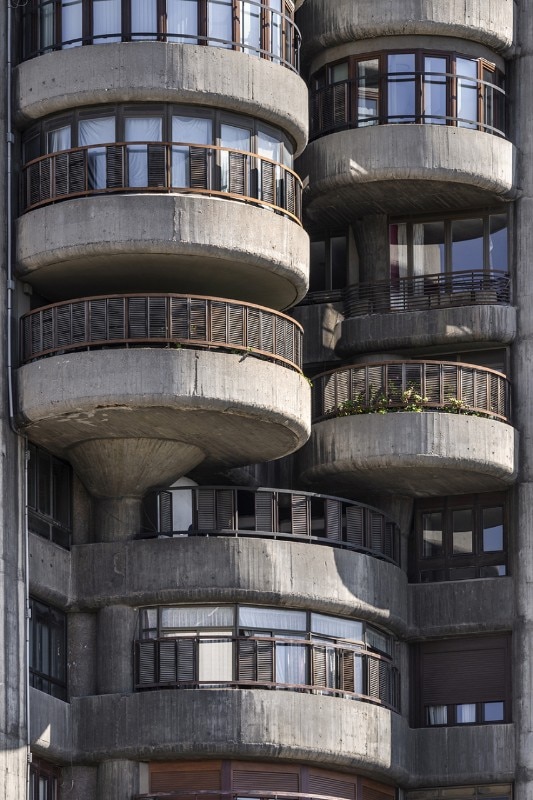A city as historically and politically important as Madrid offers a great number of architectural styles and schools, from Baroque to Renaissance, from the Art Deco of the Edificio Carriòn on the Gran Via to the contemporary skyscrapers of the Quatro Torres on the Paseo de la Castellana or the CaixaForum by Herzog & de Meuron. However, it is not spontaneous to link the Spanish capital to Brutalist architecture, although there are many examples with peculiar histories and results.
Brutalism in Madrid photographed by Roberto Conte
A photographic journey through Madrid, deep into Brutalist architecture, a genre maybe not expected and that nevertheless has considerable examples in the Spanish capital.
Photo Roberto Conte
Photo Roberto Conte
Photo Roberto Conte
Photo Roberto Conte
Photo Roberto Conte
Photo Roberto Conte
Photo Roberto Conte
Photo Roberto Conte
Photo Roberto Conte
Photo Roberto Conte
Photo Roberto Conte
Photo Roberto Conte
Photo Roberto Conte
Photo Roberto Conte
Photo Roberto Conte
Photo Roberto Conte
Photo Roberto Conte
Photo Roberto Conte
Photo Roberto Conte
Photo Roberto Conte
Photo Roberto Conte
View Article details
- Romina Totaro
- 30 January 2021
- Madrid, Spagna
Most of the architects involved in the construction sites born between the 60s and 80s in Madrid are Spanish, if not Madrilenian, given the historical period of gradual and progressive liberation of Spain from Francoism. Fernando Higueras Díaz and Antonio Miró Valverde, for example, are the authors of one of the most representative buildings of this architectural language: the Instituto del Patrimonio Cultural de España is an imposing structure with a circular plan, nicknamed “Corona de Espinas” because of its peculiar crowning.

Among the churches, instead, is exemplary the Nuestra Señora del Rosario de Filipinas, by Cecilio Sanchez-Robles Tarín of 1970, strongly inspired by Le Corbusier's modernism. The religious structure presents itself with austere volumes that overlap on the external façade, while the interior, covered by undulating forms, offers a surprising plastic effect thanks to the opening placed in correspondence of the altar. A little earlier is the Church of Santa Ana y la Esperanza located in the suburban district of Moratalaz, where the back wall, immediately behind the altar, is divided into three striking concave spaces that accommodate as many moments of the liturgical rite.
Perhaps the most iconic building is the tower known as Torres Blancas, designed by Francisco Javier Sáenz de Oíza in the 1960s. With its 25 floors distributed over 71 meters, it represents one of the most important examples of organic architecture in the Iberian country, with cylindrical elements that intersect each other in an upward progression that recalls some Japanese metabolist solutions.
Roberto Conte (1980), began photographing in 2006, initially exploring the industrial ruins around Milan and gradually expanding his range of activity to different types of abandoned places and architectures across Europe and more. He developed a particular interest for the architecture of the twentieth century: from the rationalist and constructivist avant-garde to brutalism and Soviet modernism. His images have been published on several magazines and books. In 2019, together with Stefano Perego, he published the book “Soviet Asia” (FUEL).
Instituto del Patrimonio Cultural de España (Cultural Heritage Institute of Spain), Fernando Higueras Díaz and Antonio Miró Valverde, 1964-1988
Instituto del Patrimonio Cultural de España (Cultural Heritage Institute of Spain), Fernando Higueras Díaz and Antonio Miró Valverde, 1964-1988
Torres Blancas, Francisco Javier Sáenz de Oíza, 1961-1969
Torres Blancas, Francisco Javier Sáenz de Oíza, 1961-1969
Church of Nuestra Señora del Rosario de Filipinas, Cecilio Sanchez-Robles Tarín, 1967-1970
Church of Nuestra Señora del Rosario de Filipinas, Cecilio Sanchez-Robles Tarín, 1967-1970
Church of Santa Ana y la Esperanza, Miguel Fisac Serna, 1965-1966
Department of Information Sciences (Complutense University of Madrid), José María Laguna Martínez and Juan Castañón Fariña, 1971-1979
Department of Information Sciences (Complutense University of Madrid), José María Laguna Martínez and Juan Castañón Fariña, 1971-1979
Department of Biological and Geological Sciences (Complutense University of Madrid), Fernando Moreno Barberá, 1964-1969
Department of Biological and Geological Sciences (Complutense University of Madrid), Fernando Moreno Barberá, 1964-1969
Headquarters of UGT trade union, Antonio Vallejo Acevedo, 1977
Torre de Valencia, Javier Carvajal Ferrer, 1968-1973
Torre de Valencia, Javier Carvajal Ferrer, 1968-1973
Edificio Princesa, residential buildings for the Military Housing Cooperative, Fernando Higueras Díaz, Antonio Miró Valverde and Carlos García Rodríguez, 1967-1974
Edificio Princesa, residential buildings for the Military Housing Cooperative, Fernando Higueras Díaz, Antonio Miró Valverde and Carlos García Rodríguez, 1967-1974
Edificio Los Cubos, Michel Andrault, Pierre Parat, Aydin Guvan and Alain Capieu, 1974-1981
IBM office building, Miguel Fisac Serna, 1966-1968
IBM office building, Miguel Fisac Serna, 1966-1968
Beatriz building, Eleuterio Población Knappe, 1968-1976
Beatriz building, Eleuterio Población Knappe, 1968-1976